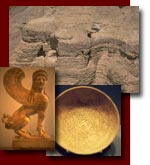| Site Map | Contacts | Links | Newsletter | |
Biblical Archaeology:
The Ten Lost Tribes of Israel
Introduction
There has been many stories as to what happened to the ten lost tribes of Israel. We will look at some of the most influential theories, but first we need to know how they got lost.
Assyria
2 Kings 17:3-6 records, "Shalmaneser king of Assyria came up to attack Hoshea, who had been Shalmaneser's vassal and had paid him tribute. But the king of Assyria discovered that Hoshea was a traitor, for he had sent envoys to So king of Egypt, and he no longer paid tribute to the king of Assyria, as he had done year by year. Therefore Shalmaneser seized him and put him in prison. The king of Assyria invaded the entire land, marched against Samaria and laid siege to it for three years. In the ninth year of Hoshea, the king of Assyria captured Samaria and deported the Israelites to Assyria. He settled them in Halah, in Gozan on the Habor River and in the towns of the Medes" (NIV).
According to these verses the king of Assyria took the ten tribes of Israel captive. He deported them to Halah (possibly Calah), to Gozan on the Habor River which is a tributary of the Euphrates River, and other towns of the Medes. The Assyrians would displace people from one area and replace them with captured people of another area in order to reduce the chance of rebellion.
2 Kings 17:24 states, "The king of Assyria brought people from Babylon, Cuthah, Avva, Hamath and Sepharvaim and settled them in the towns of Samaria to replace the Israelites" (NIV). It is also probable that some Israelites were sent to these towns as well.
Samaritans
Some say the Samaritans were the result of intermarriage of the Jews that were left in the land of Israel with the people that were deported by the King of Assyria from Babylon, Cuthah, Avva, Hamath and Sepharvaim. Nehemiah separates the pure Jews from those that intermarried (Nehemiah 13:28-29). Josephus says that the "Samaritans" is their Greek name while "Cutheans" is their Hebrew name. They were brought out of the country of Cuthah which is in Persia. They continued to worship false gods until God sent a plague resulting in their worship of the God of Israel and His laws (Antiquities of the Jews Book IX, 14:3).
According to Josephus during the Greek period Manasseh, the brother of Jaddua the high priest had married Nicaso, a foreign woman. The priests demanded that Manasseh divorce his wife or not approach the altar. Sanballat II (different from the one mentioned in Nehemiah) his father-in-law told Manasseh that he would build him a temple on Mount Gerizum just like the one at Jerusalem if he would not divorce his wife. Alexander the Great gave Sanballat, a general in his army, permission to build the temple (Antiquities of the Jews Book XI, 8:2-4). Some Two hundred years later Hyrcanus destroyed the temple on Mount Gerizum (Antiquities of the Jews Book XIII, 9:1).
The Samaritans were hated by the Jews which is seen in the New Testament. Jews would cross over to Perea to avoid going through Samaria. In John 5 Jesus goes through Samaria and talks to a Samaritan woman at the well.
Synagogues
Many Jews that were taken into Assyrian and Babylonian captivity did not return to Israel. Jews were scattered all over the known world. It is during the time between the Old and New Testaments that the synagogues were started to preserve their Jewish heritage.
New Testament
By the time of Christ the Jews had been scattered all over the Roman empire. On the Day of Pentecost Jews came to Jerusalem from "every nation under heaven" (Acts 2:5-12). On Paul's missionary trips he met Jews at every city that he visited. There were large Jewish populations at Alexandra, Egypt and Antioch in Syria. There is no mystery where the Jews were scattered to during captivity. Paul visited many of them on his missionary trips.
Mormons
After Columbus discovered America in 1492 there was much speculation as to how the Indians came to America. Joseph Smith believed that some of the Indians were from some of the tribes of Israel. Mormons believe that a family from the tribe of Manasseh migrated to the America shortly before Jerusalem was destroyed in 586 BC, and that another group migrated after the fall of Jerusalem. Smith wrote the Book of Mormon to explain about the Indians that Christ visited after he arose. Smith claims that he angel Moroni came to him and showed him where there was a book of golden plates written in hieroglyphics that he was able to translate with special glasses. This translation was the Book of Mormon. Joseph Smith's views are not backed by archaeological research. They were mere 19th century speculation about the Indians. For more information see Mormons in Transition. Does archaeology support the Book of Mormon? See The Scientific Search for Nephite Remains.
World Wide Church of God
Herbert W. Armstrong who founded the World Wide Church of God believed that the ten lost tribes of Israel were the white British-American people. There is no evidence for this.
Conclusion
The Ten Lost Tribes are not lost. They were sent into captivity by Assyria. As a result of the Assyria and Babylonian captivities colonies of Jews spread all over the ancient world. Synagogues were established. There are a number of good books that detail the history of the Jews from Bible times down to the present day which indicates that many Jews were persecuted by Christ church down through the ages. For a brief history of Israel see Facts about Israel.
